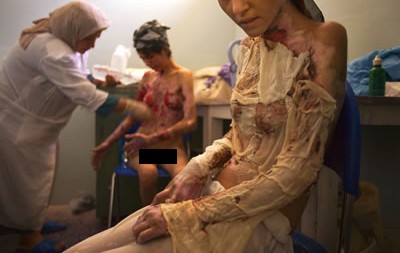By Sana Safi
Jamila (not her real name) attempted suicide after she felt abandoned and betrayed by her fiancÚ - who decided, after a six-year-engagement, that he no longer wanted to marry her because she was "not a young woman any more".
Jamila is 18 - and her family arranged her engagement when she was just 12. She was taken to a hospital in Herat by her mother and treated for poisoning last month.
Jamila is one of thousands of Afghan women who try to kill themselves every year.
About 3,000 Afghans attempt to take their own lives every year, according to the Afghan Independent Human Rights Commission (AIHRC). Herat province accounts for more than half of all cases nationwide.
According to health officials in Herat, 1,800 people tried to kill themselves in 2017 alone, of whom 1,400 were women - and 35 succeeded in taking their own lives.
The figure is almost twice as high as the year before, when some 1,000 suicide attempts were recorded.
Globally, there are more male suicides than female suicides - but in Afghanistan it is estimated that 80% of suicide attempts are made by women.
The AIHRC warns the number of attempted suicides could be even higher, "as many people in Afghanistan do not report suicide to authorities for a variety of reasons".
Many people in religious rural areas keep suicide attempts within their families to themselves, as taking one's life is stigmatised and considered un-Islamic.
There does not seem to be one single reason for Afghanistan's high female attempted suicide rate.
Hawa Alam Nuristani of the AIHRC suggests reasons could "range from mental health problems and domestic violence, to forced marriages and many other social pressures that women are increasingly facing".
What is clear is that life in Afghanistan is extremely difficult for many, especially women.
The World Health Organization (WHO) estimates that more than a million Afghans suffer from depressive disorders, and, given that the country has endured 40 years of armed conflict, the actual number could be much higher.
And violence against women is widespread. Based on the estimates of the United Nations Population Fund, 87% of Afghan women have been victims of at least one form of physical, sexual or psychological violence, and 62% have experienced multiple forms of abuse.
Forced marriages are also often quoted as a reason why women in distress seek suicide as an escape.
"One cause of female suicide is abuse, most of it starts in the family - for example forced marriages, [women] not being listened to and being stopped from continuing their education", says Ms Nuristani.
According to a Unicef report, a third of Afghan girls are married before their 18th birthday.
Poverty and lack of job opportunities are also reported by women as some of their biggest concerns, as stated in the Survey of the Afghan People, released by the Asia Foundation in 2017.
Dangerous substances
The WHO has also made a link between easy access to poison and increased suicide rates.
According to health officials in Herat, 1,800 people tried to kill themselves in 2017 alone, of whom 1,400 were women - and 35 succeeded in taking their own lives.
And in Afghanistan, one problem is that poisonous substances are easily accessible.
"In the past few years, it has become easier for people to get hold of medicines and other substances," Mohammad Rafiq Shirazi, spokesman for Herat's main hospital, told the BBC Afghan Service.
"Last year, we asked relevant organisations to take action to prevent dangerous substances from being readily available."
Medics in Herat say suicide rates will not slow down until there is a proper strategy for suicide prevention in place.
Some, like Dr Nabil Faqiryar, believe there is a need for a "nationwide plan to acknowledge the motives and causes behind women's suicides", so that the mental health crisis can be effectively tackled.
Afghan health officials in Kabul say they have outlined a national prevention plan which includes giving access to therapy centres to those suffering from mental health problems.
The Ministry of Public Health says it is gathering data to design an action plan.
The next task for the country's human rights commission, according to Ms Nuristani, is to "expand awareness campaigns to rural parts of the country, so that people know how and where to get help".
She adds: "We need to make people aware that there are ways to tackle those abuses that may push women to suicide. Most of such abuses take place in far-off, remote areas where there is a lack of awareness about the law, so people don't know that if they abuse the female members of the family then the law might punish them.
"In order to tackle this suicide crisis, or at least reduce its rate, we all need to work together."
Additional reporting by Valeria Perasso, BBC World Service social affairs correspondent, and the BBC's Mohammad Qazizada in Herat.




